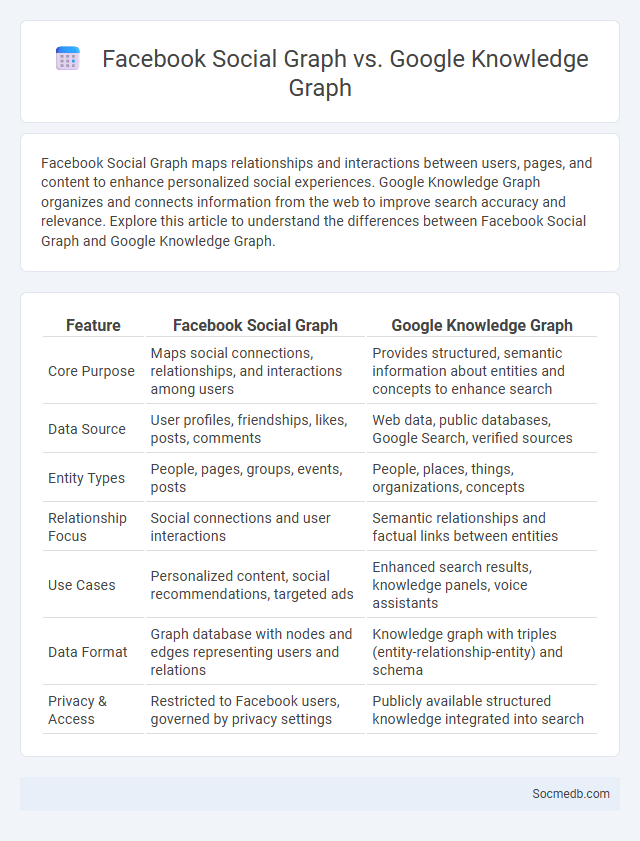
Photo illustration: Facebook Social Graph vs Google Knowledge Graph
Facebook Social Graph maps relationships and interactions between users, pages, and content to enhance personalized social experiences. Google Knowledge Graph organizes and connects information from the web to improve search accuracy and relevance. Explore this article to understand the differences between Facebook Social Graph and Google Knowledge Graph.
Table of Comparison
| Feature | Facebook Social Graph | Google Knowledge Graph |
|---|---|---|
| Core Purpose | Maps social connections, relationships, and interactions among users | Provides structured, semantic information about entities and concepts to enhance search |
| Data Source | User profiles, friendships, likes, posts, comments | Web data, public databases, Google Search, verified sources |
| Entity Types | People, pages, groups, events, posts | People, places, things, organizations, concepts |
| Relationship Focus | Social connections and user interactions | Semantic relationships and factual links between entities |
| Use Cases | Personalized content, social recommendations, targeted ads | Enhanced search results, knowledge panels, voice assistants |
| Data Format | Graph database with nodes and edges representing users and relations | Knowledge graph with triples (entity-relationship-entity) and schema |
| Privacy & Access | Restricted to Facebook users, governed by privacy settings | Publicly available structured knowledge integrated into search |
Introduction to Social Graphs
Social graphs represent the complex networks of relationships and interactions among users on social media platforms, mapping connections through nodes (users) and edges (relationships). These graphs enable platforms to analyze user behavior, recommend content, and enhance connectivity by identifying patterns like mutual friends and interest groups. Understanding social graphs is essential for optimizing engagement, targeted advertising, and developing personalized user experiences.
What is Facebook Social Graph?
Facebook Social Graph represents the digital map of relationships between users, pages, and content within the Facebook network. It structures data based on connections such as friendships, likes, comments, and shares, enabling personalized user experiences and targeted advertising. This interconnected network helps developers and businesses analyze user interactions and optimize social engagement strategies.
What is Google Knowledge Graph?
Google Knowledge Graph is a powerful semantic database that organizes information about entities, their attributes, and relationships to enhance search results with rich, relevant data. It enables Google to understand the context behind your queries, providing concise answers and detailed knowledge panels instead of just links. By leveraging the Knowledge Graph, your social media content can gain improved visibility and engagement through enhanced search prominence.
Defining the General Social Graph
The General Social Graph represents the complex web of relationships and interactions among users across various social media platforms. It maps connections such as friendships, followers, and group memberships, enabling analysis of influence, community structures, and information flow. Understanding this graph is crucial for optimizing social network algorithms, targeted advertising, and enhancing user engagement strategies.
Core Differences: Social vs Knowledge Graphs
Social graphs map relationships and interactions between individuals or groups, emphasizing connections such as friendships, followers, and social networks. Knowledge graphs organize and link structured information about entities, concepts, and their attributes to enable deeper understanding and data integration. Your digital strategy should leverage social graphs for engagement and knowledge graphs for enhanced data-driven insights.
Data Sources: Facebook vs Google
Facebook generates data primarily from user interactions such as likes, shares, comments, and friend networks, providing rich social graph insights for targeted advertising. Google collects vast keyword search queries, browsing history, and location data from its search engine, YouTube, and Android ecosystem, offering intent-based targeting capabilities. Both platforms leverage massive datasets but differ in user behavior context--Facebook emphasizes social connections while Google centers on search intent and online activity patterns.
User Privacy and Data Control
User privacy on social media platforms is critical as personal data is often collected, stored, and shared with third parties without explicit consent. Implement robust privacy settings to gain control over Your information and limit data access by advertisers or unauthorized users. Leveraging tools like end-to-end encryption and regular privacy audits helps protect Your digital footprint from breaches and misuse.
Applications in Social Networking and Search
Social media revolutionizes applications in social networking and search by enabling real-time communication, content sharing, and personalized information discovery. Platforms like Facebook, Instagram, and LinkedIn use advanced algorithms to connect users with relevant content, people, and businesses, enhancing your social and professional interactions. Search functionalities within social media integrate user behavior, preferences, and trends to deliver precise and dynamic search results tailored to your interests.
Impact on Content Discovery and Recommendations
Social media algorithms analyze user behavior to personalize content discovery, making it easier for you to find relevant posts, videos, and articles tailored to your interests. These platforms use machine learning to optimize recommendations, increasing engagement by suggesting trending topics and influencers aligned with your preferences. As a result, social media significantly shapes your content consumption patterns by filtering vast information into curated streams.
Future Trends: Evolving Graph Technologies
Future trends in social media highlight the rapid advancement of evolving graph technologies, enabling more sophisticated user interaction and data visualization. Graph databases and machine learning algorithms improve relationship mapping, enhancing personalized content delivery and community detection. These innovations drive deeper insights into social networks, fostering dynamic and immersive user experiences.
 socmedb.com
socmedb.com